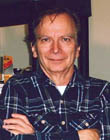|
|
This topic comprises 3 pages: 1 2 3
|
|
Author
|
Topic: Edit Splices
|
|
|
|
|
John Pytlak
Film God

Posts: 9987
From: Rochester, NY 14650-1922
Registered: Jan 2000
|
 posted 02-23-2004 01:38 PM
posted 02-23-2004 01:38 PM





Christian is correct: the film edges of splices refract light passing through the spliced negative during printing, leaving an unexposed line across the width of the film. Same reason that base-side scratches on a negative element show up as white on the final print. Sometimes a bit of splicing cement "oozes" outside the overlap area, showing up on the screen.
SMPTE Recommended Practice RP111 is very specific about the dimensions of cement splices, including the overlap that should not fall into the projectable image area (0.825 x 0.690 inches for 2.39:1 "scope"). It's really a matter of the splicer used, and the negative cutter's splicing technique. Yes, increasing the overlap of a cement splice increases the reliability and reduces the risk of the splice breaking, but with more likelihood it will be seen on the screen.
One way to eliminate any splices being seen is to edit the negative into two rolls with alternating scenes and black leader, and use "zero-cut" editing:
http://www.acvl.org/manual/3c.htm#Zero%20cuts
quote:
Zero cuts
Another method of achieving invisible splices in printing from A and B rolls is to use the checkerboard technique, but extend each end of each scene at least two frames. When rolls so prepared are placed in a synchronizer, there would be a four-frame overlap at the head and tail of each scene. Rolls prepared in this manner must be printed on a printer that will make scene changes by means of a shutter that rapidly opens or closes. Not all laboratories are equipped to print rolls prepared for zero cut, so check with your lab. Zero cuts made on a 16mm continuous release printer usually appear as less than one frame dissolves. Zero cuts made on 16mm step contact or optical printer will appear as a perfect straight cut.
quote:
Black leader
It is recommended that only black leader be used between scenes. To insure that the leader is opaque, it is suggested that the black leader be made by fully exposing a positive stock and developing in a positive bath to a minimum density of 3.00. Specify this minimum density when ordering black leader from your lab. If the black leader is old, it is wise to check it for shrinkage. Use black leader for 16mm negative A and B rolls and for 35mm negative rolls prepared for the checkerboard technique.
| IP: Logged
|
|
|
|
|
|
|
|
|
|
|
|
|
|
|
|
|
|
|
|
|
|
|
|
|
|
|
|
All times are Central (GMT -6:00)
|
This topic comprises 3 pages: 1 2 3
|
Powered by Infopop Corporation
UBB.classicTM
6.3.1.2
The Film-Tech Forums are designed for various members related to the cinema industry to express their opinions, viewpoints and testimonials on various products, services and events based upon speculation, personal knowledge and factual information through use, therefore all views represented here allow no liability upon the publishers of this web site and the owners of said views assume no liability for any ill will resulting from these postings. The posts made here are for educational as well as entertainment purposes and as such anyone viewing this portion of the website must accept these views as statements of the author of that opinion
and agrees to release the authors from any and all liability.
|

 Home
Home
 Products
Products
 Store
Store
 Forum
Forum
 Warehouse
Warehouse
 Contact Us
Contact Us




 Printer-friendly view of this topic
Printer-friendly view of this topic











![[Smile]](smile.gif) ). Then they showed up at the top. I figured he just lowered it too much. I hope I'll be able to find just the right spot that gets rid of these splices on screen.
). Then they showed up at the top. I figured he just lowered it too much. I hope I'll be able to find just the right spot that gets rid of these splices on screen.

![[Wink]](wink.gif)

![[thumbsup]](graemlins/thumbsup.gif)



